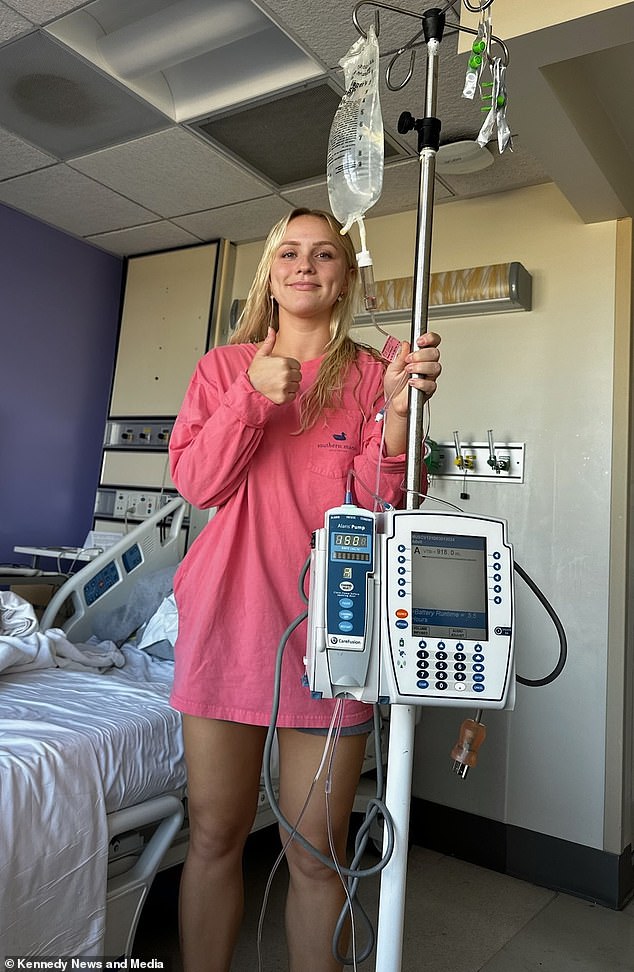Doctors issue warning over CrossFit challenge as South Carolina woman’s biceps ‘EXPLODE’ from doing so many pull-ups
A South Carolina woman claims her biceps in both arms “exploded” after attempting a CrossFit challenge.
Jessica Johnson, 25, had just started training last month for the intense Murph Challenge, which involves two one-mile runs and hundreds of push-ups, pull-ups and squats.
Her arms were “super sore” and swollen after doing 50 pull-ups in preparation for the challenge, but she thought it was because she had trained them so hard.
Within four days, the health care provider said, she felt “like the Hulk” as her arms swelled and she lost feeling in her hands.
Her muscles had actually started to break down and die from a condition called rhabdomyolysis, which caused large amounts of chemicals like potassium to enter her bloodstream and attack her kidneys and liver, potentially causing fatal organ failure if left untreated.
Jessica Johnson, 25, had done 50 pull-ups as part of the intense Murph Challenge when her arm muscles ‘exploded’

Mrs. Johnson’s arms swelled (pictured here) so much that she had difficulty brushing her teeth or showering. She spent four days in the hospital receiving IV fluids and electrolytes
She also noticed that her urine had become much darker than normal, almost looking orange because of the excess toxins and waste products.
“I was absolutely shocked and didn’t know this could happen,” Johnson said in a TikTok video. “Ending up in the hospital with rhabdomyolysis was definitely not on my 2024 bingo card.”
The Murph Challenge is a workout regimen that consists of two one-mile runs, 100 pull-ups, 200 push-ups, 300 air squats. This generally takes about 40 minutes to an hour.
Ms. Johnson had just started the challenge the week of her injury, initially focusing on 10 sets of five pull-ups.
“I left the gym feeling pretty tired. I thought, ‘Oh man, I’m going to be so sore tomorrow.’ I hadn’t worked my arms like that in a while,” she said.
When she woke up the next morning, she noticed that her arms were so swollen that she had difficulty brushing her teeth and taking a shower.
“I thought, ‘Oh my God, my arms won’t work right,'” she said. “I couldn’t straighten my arms all the way.”
‘There was visible swelling. I looked like the Hulk. Everyone was like, “We just thought you were super muscular or something.”‘
Meanwhile, Mrs. Johnson’s muscle fibers, which make up muscle tissue and control its functions, had been stretched and weakened by the tension.
Without this structure, the fibers begin to loosen, leading to muscle breakdown and eventual muscle death.
Despite staying hydrated throughout the day, “I didn’t pee much during the day. I thought that was a little weird,” Ms. Johnson said.
“I was a little nervous because I didn’t know what was going on.”
Four days after exercising, Mrs. Johnson rushed to her local emergency room, who immediately referred her to the emergency room and confirmed she had rhabdomyolysis.
“The doctors were very sure it was the pull-ups that did it,” she said. “They had to practically cut my arms open to get the tension out of my arms.”

Ms Johnson, pictured at the gym, had initially ignored her swollen muscles but doctors warned she had suffered damage to her kidneys and liver


Ms. Johnson said she no longer plans to complete the Murph Challenge and will instead focus on lower-intensity exercises such as Pilates. Her doctors advised her to slowly ease back into exercise
Fortunately, doctors were able to stabilize Mrs. Johnson’s condition for four days with the help of intravenous fluids and electrolytes.
Rhabdomyolysis manifests itself in harmless symptoms such as tender and swollen muscles, but it can be dangerous to organs such as the kidneys.
As muscles deteriorate, large amounts of chemicals such as potassium, phosphate, and creatinine are released into the bloodstream.
Normally the kidneys filter these out through the urine, but with large amounts the kidneys have difficulty keeping up.
As a result, these chemicals build up, leading to kidney damage and kidney failure.
This could explain why Mrs. Johnson’s urine turned orange.
“They were mostly concerned about my organs. With rhabdomyolysis, your cells in your muscles explode. Your muscles burst,” she said.
Mrs Johnson suffered damage to her kidneys and liver, but made a full recovery and was discharged from hospital four days after her admission.
Although the condition seems serious, rhabdomyolysis is quite common, affecting about 26,000 Americans each year and killing about one in twenty.
In most cases it is caused by traumatic injury, intense exercise, severe dehydration, long periods of inactivity, and substance abuse.
People with more severe damage may need dialysis to filter toxins from their bodies, as the kidneys normally do.
“People have died from it in the past. I’m absolutely grateful that I haven’t had any of those problems,” she said.
Ms. Johnson also noted that doctors warned her to stay away from “crazy workouts” and to slowly transition back into gentler forms of exercise, such as walking and Pilates.
“I’ve decided I’m not going to train for the Murph. It’s not worth being in the hospital again,” she said.
“It was definitely a wake-up call that I don’t have the body of a high school teenager anymore. As we get older, we have to take care of our bodies.”
“Listen to your body and take it easy. Yes, it’s very good to train your body. It’s healthy to do that. But I think it’s more important now than ever to share it with people.”
“Overtraining and doing too aggressive a workout is not good for you and it’s not healthy. I think some people need to hear that.”
